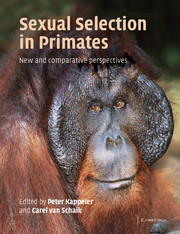Book contents
- Frontmatter
- Contents
- List of contributors
- Foreword by Robert L. Trivers
- Preface
- PART I INTRODUCTION
- PART II SEXUAL SIGNALS: SUBSTRATES AND FUNCTION
- PART III SEXUAL SELECTION IN ACTION
- 7 Sexual selection, behaviour and sexually transmitted diseases
- 8 Mating conflict in primates: infanticide, sexual harassment and female sexuality
- 9 Post-copulatory sexual selection in birds and primates
- PART IV DEVELOPMENT AND CONSEQUENCES
- Index
- References
9 - Post-copulatory sexual selection in birds and primates
Published online by Cambridge University Press: 10 August 2009
- Frontmatter
- Contents
- List of contributors
- Foreword by Robert L. Trivers
- Preface
- PART I INTRODUCTION
- PART II SEXUAL SIGNALS: SUBSTRATES AND FUNCTION
- PART III SEXUAL SELECTION IN ACTION
- 7 Sexual selection, behaviour and sexually transmitted diseases
- 8 Mating conflict in primates: infanticide, sexual harassment and female sexuality
- 9 Post-copulatory sexual selection in birds and primates
- PART IV DEVELOPMENT AND CONSEQUENCES
- Index
- References
Summary
INTRODUCTION
Post-copulatory sexual selection comprises two processes: sperm competition and cryptic female choice (Birkhead & Møller, 1998). Sperm competition is the inevitable consequence of females copulating with and being inseminated by more than one male during a single reproductive cycle: the sperm of different males compete to fertilise the female's ova. Cryptic female choice can similarly occur only when females are inseminated by more than one male, but – so far, at least – it does not appear to be inevitable. The evolutionary significance of these two processes has become apparent only since the 1970s; before that it was assumed that females in many taxa typically copulated with only a single male during any reproductive cycle. Recognition of the ubiquity of these post-copulatory mechanisms of sexual selection has created new opportunities to study the dynamic interactions between the sexes, which are being fuelled by the fundamental conflict between males and females over the maximisation of their reproductive success at yet additional frontiers (e.g. Johnstone & Keller, 2000). Furthermore, consideration of post-copulatory mechanisms can inform analyses and interpretation of pre-copulatory reproductive strategies of both sexes (Parker, 1970, 1984). In this chapter, we review mechanisms and consequences of post-copulatory sexual selection in two groups of animals for which some of the most detailed behavioural data exist, and which differ fundamentally in reproductive physiology and their modal social and mating systems: birds and primates.
- Type
- Chapter
- Information
- Sexual Selection in PrimatesNew and Comparative Perspectives, pp. 151 - 172Publisher: Cambridge University PressPrint publication year: 2004
References
- 21
- Cited by

